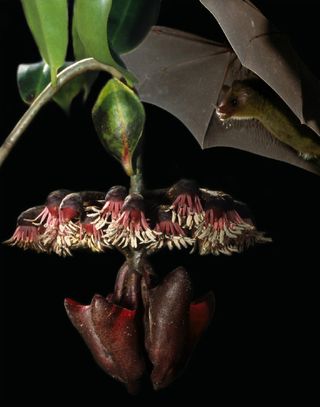Holy Talking Plant! Flower Communicates with Bats

Just as some flowers use bright colors to attract insect pollinators, other plants may use sound to lure in nectar-eating bats.
One rain-forest vine has a dish-shaped leaf located above a cluster of flowers that appears to help bats find them (and the plant's tasty nectar) by reflecting back the calls the flying mammals send out, new research indicates. [Video of the Discovery]
While there is other evidence that plants use bats' sonar systems to attract them, this is the first time scientists have shown that a plant can produce an "echo beacon" that cuts through sonic clutter of reflected echoes, and that this signal can cut a bat's search time for food in half, according to the researchers, led by Ralph Simon, a research fellow at the University of Ulm in Germany.
The vine, Marcgravia evenia, climbs trees in the rain forests of southeastern Cuba. Its flowers are suspended in a ring, above cuplike structures that hold sugary nectar intended to lure batty pollinators, whose necks and shoulders are powdered with pollen as they drink the nectar. The bats then carry the pollen between vines, fertilizing other flowers with it and helping the vine reproduce. [Image of "screaming" vines]
Like a satellite dish, the reflector leaf is concave, and stands in an upright position above the ring of flowers.
Bats navigate and search for food by sending out high-frequency calls, and then listening to the echoes that bounce back.
And like bats would, the researchers bounced sound off the dish-shaped leaves as well as off regular foliage leaves and then analyzed the echoes that came back. They found that a strong, constant echo could be detected within a roughly 100-degree range around the front of the dish-shaped leaves. Meanwhile, the echo from the foliage leaves was not constant, but varied drastically within 5-degree increments, making it less detectable. What's more, the dish-shaped leaves produced an echo with a distinctive, two-peak signal.
Sign up for the Live Science daily newsletter now
Get the world’s most fascinating discoveries delivered straight to your inbox.
In another experiment, the researchers trained nectar-feeding bats to find a small, single feeder (a stand-in for a nectar-filled flower bloom) hidden within fake foliage in the rainforest. The bats then searched for the feeder, which was associated with a replica of a dish-shaped leaf, a foliage leaf or no leaf, as they were timed.
The bats took the longest to find the feeder when it had no leaf, though the foliage leaf did not significantly reduce the search time. However, the dish-shaped leaf cut down the bats' search time by roughly 50 percent relative to the feeder by itself.
The vine has a great deal to gain by attracting bats, according to Simon.
"Bats are very efficient pollinators, and they have large home ranges," Simon said. "[The vine] is a rare species with a patchy distribution pattern. These bats are extremely helpful, because they can exchange pollen between plants that grow far apart."
The research team included Marc Hodleried of the University of Bristol in the United Kingdom, and Corinna Koch and Otto von Helversen of the University of Erlangen-Nuremburg in Germany.
You can follow LiveScience writer Wynne Parry on Twitter @Wynne_Parry. Follow LiveScience for the latest in science news and discoveries on Twitter @livescience and on Facebook.
Most Popular





